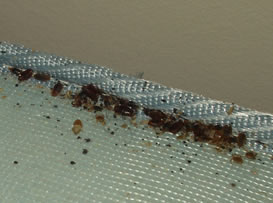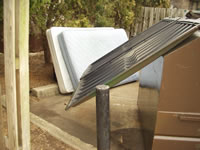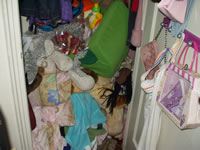EnviroTech Exterminating
Pest Control, Nuisance Wildlife Animal Removal & Termite Services
Broken Arrow, Oklahoma
www.GotPest.com
Call (918) 282-7621
Harold Harlan, who was a career bug expert for the military, is a prominent authority on bed bugs. Below, he answered a few frequently asked questions:
Are bed bug attacks a sign of dirty living conditions or living in older homes/building, or is anybody at risk?
Infestations of common bed bugs, Cimex lectularius L., are not directly related to sanitation levels. The cleanest living area can have a very large infestation , and improving sanitation alone will not eliminate an established bed bug population. Cluttered conditions can offer the bugs a lot of excellent harborages very near their human blood-meal hosts. Almost anyone is at risk of having an infestation if bed bugs are brought into their home.
Can you get anything serious from a bed bug bite? Are there physical/physiological effects if you are living with bed bugs? According to scientists, naturally occurring populations (infestations) of common bed bugs have been documented to have at least 28 different kinds of human pathogens in their bodies. However, very careful and detailed studies by both entomologists and medical doctors have never shown that those bed bugs could transmit (infect) even one of those pathogens to humans or lab animals. They simply have not been shown to transmit any human disease known so far.
When a bed bug feeds, it injects saliva into its blood-meal host, and that saliva contains several proteins which can routinely cause an allergic response from most hosts. The severity and timing of those reactions depends on the bitten person’s immune response to the salivary allergens, and they can vary greatly from one individual to another.Typical reactions to bed bug bites usually include some level of local reddening, minor swelling, inflammation and itching (which can be very intense, and can sometimes recur without another bed bug bite) at each bite site. A person being repeatedly bitten by bed bugs can be very uncomfortable, develop lots of reddish, itchy welts (at bite sites) and often have difficulty sleeping. The more bugs present, the more bites they inflict, and the worse the problems usually become (tending to be progressive as the bug numbers increase – usually rapidly). Also, some people can be significantly affected by the social stigma of having a bed bug infestation in their home.
 |
| Microscopic view of Bed Bug |
If you are a home owner and have an infestation, and you do all the preliminary cleaning and self-help steps, is an exterminator really necessary? Are there sprays/home cures?
Most people who work in urban pest control in the U.S. would prefer to be called Pest Management Professionals (PMPs) rather than exterminators. Unfortunately (as stated above), cleaning alone will not usually have much impact on an established bed bug population. Successful programs to eliminate these bugs require detailed knowledge of their biology and exact harborage (hiding) locations determined by thorough inspection. PMPs must also know a lot about the strategies, techniques and products which can be used effectively, safely, and legally to control bed bugs. The vast majority of laymen could not expect to effectively control even a very small and localized infestation; and they probably could not even tell if their efforts had any impact. Under current conditions, the use of some kind of residual (long lasting), properly labeled insecticide is needed to effectively control bed bugs in the U.S., and any practical control effort could not be carried out without use of such a product. The U.S. EPA-approved insecticide products that are currently labeled against bed bugs must still be used properly and applied at the proper sites (in the proper formulations and concentrations) to be effective. No “home cures” I have encountered so far have much affect at all against bed bugs. Regardless of any specific material used, self-help efforts seldom have a noticeable impact because individuals do not have the background knowledge or technical support needed.
Why are the bugs hard to kill?
Common bed bugs are small, thin, and can hide deep in very narrow cracks. They are mainly active at night. They will routinely travel as far as a 20-foot radius from their hiding places (and back) in one night to take a blood meal. Bed bugs are very adaptable. They move much quicker, and can pass through much smaller openings or cracks, than most people expect. Even Ph.D. entomologists who work with live bed bugs for the first time are often surprised. Bed bugs can detect (and often avoid) chemical deposits such as some cleaning agents. Adult bed bugs can live longer than a whole year without feeding and most currently labeled insecticides used against them in the U.S., Canada, Europe and Australia, do not last more than one to three months when applied by a well-trained and competent PMP. In addition, there are reports in older literature that state that certain populations of bed bugs have developed physiological resistance to specific chemical insecticides in past, making these products ineffective. Although such true resistance has not been documented or reported against any currently labeled and commonly used insecticides, it could be developing in field populations and it should be screened for by professional diagnostic labs. Such testing (screening) in North America and Europe has only recently begun and has been very limited, so far.
If you don’t have an infestation in your home, are there things you can do to prevent one?
Take steps to try to avoid picking up bed bugs from hotels, hostels or any other sources when you or your family members travel, even to local destinations (e.g., within the same or a nearby city). Do not buy used furniture (especially bedding items or upholstered items), or at least do not bring them into your home until you, or a competent expert, have inspected them carefully for any signs of bed bugs (live or dead bed bugs, their eggs, fecal spots, or cast skins). Also consider covering all of your mattresses and box springs with a plastic cover which you can seal shut to prevent such pests from getting into them (or to permanently trap any already there). Periodically inspect bedding and other places in your home which are typical harborage sites for bed bugs. No control efforts (or products) are needed unless an infestation is detected and verified by an expert. If an infestation is confirmed, it is wise to consider contracting with a properly licensed, trained, and experienced (with bed bug control) local PMP or company. They should help with effective and thorough inspections, to provide you with information you may want, and to carry out any needed control effort under a suitable contract. Be sure to ask any questions you may have before you sign a control contract. Web sites of several Co-Operative Extension offices (at the state government level) and Universities, as well as trade associations (like the NPMA), and urban pests management (often called ‘pest control’) trade journals, currently offer fairly good, informative and balanced fact sheets and additional information on bed bugs. Educating yourself can be quite helpful and re-assuring.
How would one go about avoiding them at hotels?
Inspecting fairly thoroughly for signs of bed bugs when you first arrive in a room can be very helpful. Include checking the bedding (especially near any attached type of bed headboard), the luggage holding rack, night stands by any bed (remember to check underneath and inside drawers if possible), closet shelves, dresser drawers, and along carpet edges under and near (e.g., within about 5 feet of) any bed. Report any evidence of bed bugs to the management immediately for their corrective actions. Just moving to a different room may not be the total answer. You should repeat the thorough inspection of any new or different room you are offered. When you pack to leave, inspect your luggage carefully first, and inspect every item as you pack to help detect any bugs or their signs. Laundering most cloth items with typical hot water and detergent followed by drying on low heat for at least 20 minutes (or standard dry cleaning) should kill all bed bugs in or on such items. Sealing freshly-laundered items inside a plastic bag should help keep any more bed bugs from getting in those items later to hide (and be carried back with you). Initially detecting and then excluding the bugs is the usually best strategy.
Bed bugs were almost eradicated years ago – why are they back these days?
Many factors probably have contributed to this apparently sudden bed bug resurgence. It is hard to say any one factor is the most important in every situation. A few of the most probable factors include: much more rapid travel over greater distances on both a local and global scale (e.g., flying to or from Europe, Africa, Asia, etc., or any closer destination, in less than 24 hrs.); much less current overall public and PMP knowledge about these bugs, their biology and effective control strategies (i.e., many PMPs in developed countries have only begun trying to learn about and control bed bugs in the last 3-5 years); changes in available properly-labeled insecticides to less toxic, less persistent, chemical active ingredients and formulations; and some construction practices and furniture design choices in hotels, motels, and homes. Grossly ineffective self-help “control” practices which probably help spread infestations include: throwing out infested furniture (without any inspection or treatment to try to remove the bed bugs present) which is often picked up by someone else for their own use; leaving a room vacant for a few days as a means of getting rid of bed bugs present (this does not work and may make them migrate and spread out to find a blood meal); very inadequate partial or spot treatments by occupants of infested rooms or homes (even the use of most kinds of total-release aerosols or “bug bombs” is very ineffective); and placing infested items outdoors in either hot sun (by day) or below freezing temperatures (overnight) to kill infesting bed bugs (both of which are generally not effective).
The story is on 'Dateline' and all over local news all over. It has even been called the “scourge of America.” Is the threat as bad as it appears?
It may not be quite as bad as that, but there is no doubt that bed bug infestations are being reported more often and from more and more places world wide.Currently, controlling bed bugs in most situations is certainly not a simple or easy thing to do. It requires considerable time, technical knowledge, and assistance by occupants or property managers for the most competent and best trained and experienced PMPs to effectively eliminate established bed bug infestations. Occupant compliance, especially regarding reducing clutter, making infested spots fully accessible for inspection and treatment is crucial for successful bed bug control. Under the best of situations, at least two separate visits by a PMP should be expected as a minimum. Thus the cost of technical labor, and related overall cost for control, is often higher than expected. Litigation is becoming a significant concern for the hospitality industry in the U.S. and abroad (you can check recent news stories for good examples). Personal discomfort and the distasteful aspect of “being bitten” by these bugs can be very significant on a personal level and must be considered a growing problem for the general public. There are also a few cases of true allergy (anaphylactic reactions) being infrequently reported, and as more people are bitten or exposed to the bugs, those cases should be expected to increase, too.
If you have a Bed Bug problem and live in the Tulsa or Broken Arrow, Oklahoma area you need a Pest Control Professional Immediately. Call EnviroTech Exterminating for a consultation at (918) 282-7621














